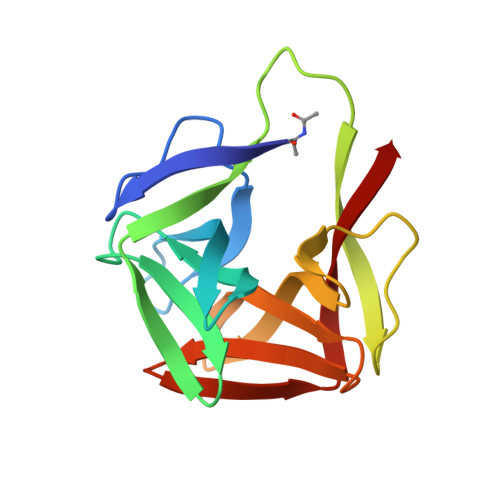Mannose oligosaccharide recognition of CGL1, a mannose-specific lectin containing DM9 motifs from Crassostrea gigas, revealed by X-ray crystallographic analysis.
Hatakeyama, T., Masuda, K., Kudo, M., Tanaka, K., Takeuchi, A., Unno, H.(2023) J Biochem 175: 35-41
- PubMed: 37793172
- DOI: https://doi.org/10.1093/jb/mvad073
- Primary Citation of Related Structures:
8JE9, 8JEA, 8JEB - PubMed Abstract:
CGL1 is a mannose-specific lectin isolated from the Pacific oyster Crassostrea gigas, and it belongs to the DM9 domain protein family. Each subunit of the CGL1 dimer consists of a tandem repeat of DM9 motifs, which were originally found in the Drosophila melanogaster genome. The CGL1 protomer contains two carbohydrate-binding sites: a high-affinity site A and a low-affinity site B. An assay using dendrimers containing oligomannose from yeast (Saccharomyces cerevisiae) revealed that CGL1 exhibited significantly higher affinity for mannotetraose (Man4) compared to mannobiose (Man2) and mannotriose (Man3). To investigate its oligomannose-recognition mechanism, X-ray crystallographic analyses of CGL1/oligomannose complexes were performed. In the CGL1/Man2 and CGL1/Man3 complexes, Manα1-2Man and Manα1-2Manα1-2Man, respectively, were primarily bound to site A, interacting with the non-reducing mannose residue. On the other hand, in the CGL1/Man4 crystal, Man4 (Manα1-2Manα1-2Manα1-6Man) was bound at both site A and site B at the non-reducing and reducing ends, thus linking adjacent CGL1 molecules with crystallographic symmetry. These findings suggest that CGL1 can recognize both the non-reducing and reducing mannose residues of mannose oligosaccharides at its two distinct carbohydrate-binding sites. This enables efficient complex formation, making CGL1 a pattern-recognition molecule capable of recognizing diverse structures of mannose-containing carbohydrate chains.
Organizational Affiliation:
Biomolecular Chemistry Laboratory, Graduate School of Engineering, Nagasaki University, Bunkyo-machi 1-14, Nagasaki 852-8521, Japan.



















